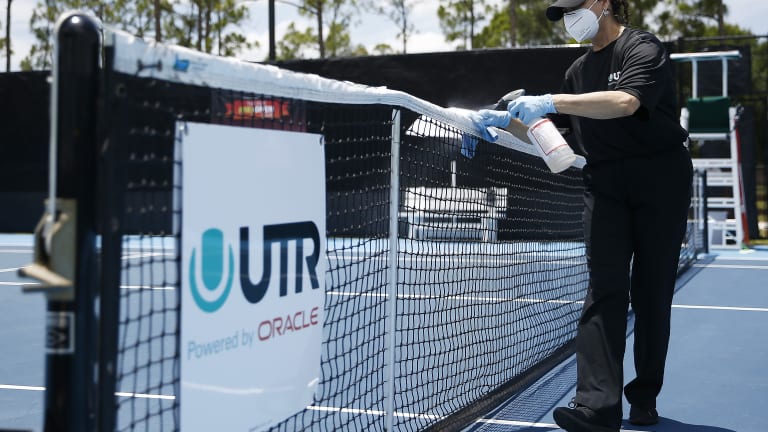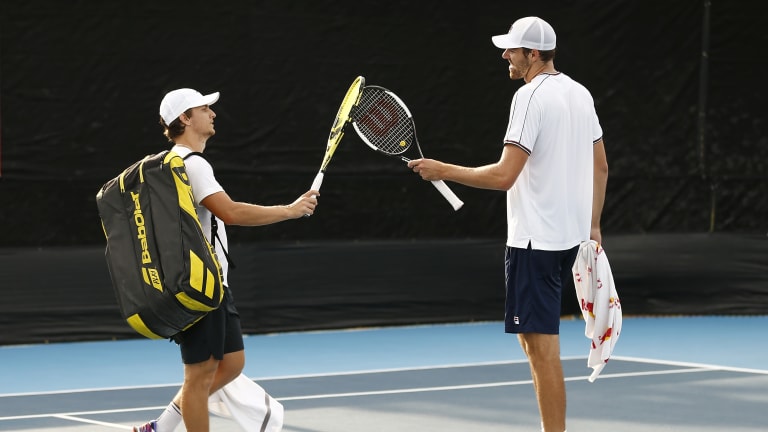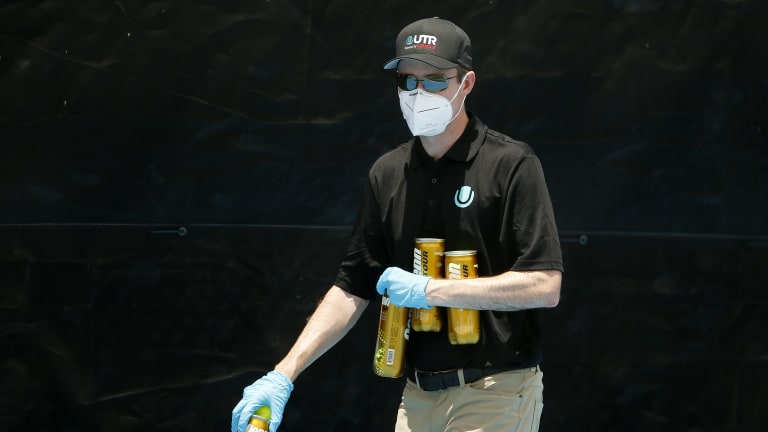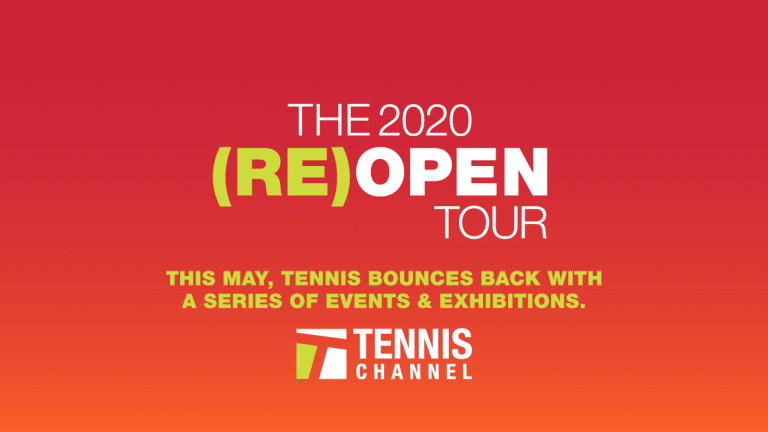The Rally: How do we feel about tennis' new, fan-less template?
May 11, 2020Laver Cup
Rafael Nadal accepts Bjorn Borg's Laver Cup invitation to play for Team Europe in Berlin
By TENNIS.com Apr 22, 2024Social
Big 3 salutes their retiring 'friend' Joao Sousa in Estoril
By Baseline Staff Apr 07, 2024Social
Roger Federer to deliver commencement speech at Dartmouth College
By Ed McGrogan Mar 28, 2024Miami, USA
Top 5 Miami Finals, No. 1: Roger Federer d. Rafael Nadal, 2005
By Steve Tignor Mar 27, 2024Social
Coco Gauff wants to play as the Big Three after TopSpin 2K25 unveils full player roster
By Stephanie Livaudais Mar 23, 2024Lifestyle
Roger Federer opens up on retirement to GQ: He doesn't miss pro tennis, but hitting a forehand is 'like riding a bike'
By Baseline Staff Mar 15, 2024Indian Wells, USA
Top 5 Indian Wells Finals, No. 4: Dominic Thiem d. Roger Federer, 2019
By Steve Tignor Mar 13, 2024Pop Culture
Carlos Alcaraz can’t wait to “play as myself” in upcoming TopSpin 2K25 tennis video game
By Stephanie Livaudais Mar 13, 2024Pop Culture
Roger Federer is California dreamin' as he takes in Golden State Warriors game, attends Oscars
By Baseline Staff Mar 10, 2024The Rally: How do we feel about tennis' new, fan-less template?
As they say, it’s all about the tennis, and that’s the only thing it’s going to be about for the foreseeable future.
Published May 11, 2020
Advertising
In this week’s Rally, Joel Drucker and Steve Tignor discuss this weekend’s My UTR events, and whether they could be a template for pro tennis in the immediate future. Connect with Steve and Joel on Twitter by using the hashtag #MondayRally.
Steve,
It’s been fascinating to watch the UTR Pro Match Series. Nice indeed to have a chance to see live competitive tennis. Impressive to see all the steps taken to ensure proper social distancing. It’s a good start and I’m curious to see how these events evolve.
Watching Reilly Opelka, Tommy Paul, Hubert Hurkacz and Miomir Kecmanovic in action made me think about what’s in my head during tennis matches. Sometimes, it’s the backstory. How did this guy get into tennis? Who were his idols? How did he become great? What if he hadn’t been a tennis player? It made me think that with so much of tennis currently in a holding pattern, now is a good time to dig out and tell more up close and personal stories about these guys and many others.
But then there’s what accompanies watching the tennis itself—the display of world-class skills, including rather melodic and comforting memories. We’ve all seen Roger Federer play so often that we carry an expectation in our head about the chance to witness yet another crackling forehand or majestic backhand. It’s like going to a concert, savoring our hope that the band will sing those familiar tunes. Or perhaps there’ll be some new material, as Federer showed a few years ago when he sang out sweetly with his upgraded topspin backhand.
So given that these four haven’t yet racked up too many big and memorable hits, at first it was a bit hard to feel in sync with it all when the event started on Friday. I just don’t know yet what a Tommy Paul song sounds like. But a few games into the opener between Paul and Hurkacz, an excellent rally broke out. That was great. Then, on Saturday, Hurkacz hit a remarkable tweener winner versus Opelka. Long live rock. After all, it’s dazzling points and shots that most make tennis compelling.

The Rally: How do we feel about tennis' new, fan-less template?
© Getty Images
Advertising
Getty Images
I also thought about how much fun it is to watch a tennis match surrounded by other people. All my life, be it at a public park, the TV room of my club, or inside Arthur Ashe Stadium, I have enjoyed kibbitzing with my fellow spectators, more in the manner of a baseball game than the opera. Not having that for this recent event was of course necessary, but also somewhat jarring. It made me wonder if a fun way to enjoy these UTR Pro matches would be to organize a Zoom or Google Hangouts tennis party with friends so we could all take it in together and make all sorts of random comments. A guy I play with, for example, constantly inspects split steps. And my friend the psychologist is always on the alert for parental dysfunction.
What’s captured your attention from this event, Steve?
Joel,
There have been times in my life, usually immediately after Grand Slams or near the end of seasons, when the last thing I’ve wanted to do is watch another tennis ball cross another net. At those moments, I feel like I’ve seen enough of the sport to last a lifetime.
How quickly things can change! By the time the recent exhibitions in Germany and Florida were announced, I was more than ready to sit down and stare at any match that came on TV screen, for as long as it lasted, no matter who was playing and how few people were in the stands.
My first reaction to seeing the Florida site this weekend—a private court surrounded by a field—made me feel as if the earth had been hit by a meteor and that civilization had been forced to begin all over again. Whatever system that had led to the glories of Wimbledon and the US Open had been wiped out, and we were picking up the pieces wherever we could. In a sense, that’s exactly what has happened, minus the meteor. But we have to start somewhere, and it was good to see that efforts had begun to find ways to make tennis happen again.
When the lockdowns began, and the idea of staging sporting events in front of no spectators was first broached, I scoffed. And it was indeed weird to watch the sport played in absolute silence this weekend. Even if someone hits a scorching tweener or a perfect lob, it’s hard to know how excited to get over a winning shot if no one else is clapping, isn’t it? Still, I didn’t really care; seeing professional competition again was what mattered. I even liked that the only spectator during Saturday’s Reilly Opelka-Hubert Hurkacz match was a cow.
The Cleaning Crew—How the UTR Pro Match Series safely took place:
Advertising
What mattered to me, it became clear, was something that you mentioned, Joel: The rhythm of tennis. That’s what drew me back in. The mix of manic energy during points, and total calmness between them. The silent concentration of the players. The sound of a shot hitting the sweet spot. I had missed having the flow and cadence of tennis on my TV and in my daily life.
I guess the next question is whether these types of events could ever fill the gap in tennis fans’ lives. This set-up isn’t going to make any of us forget Wimbledon any time soon, but can we look ahead and imagine, say, a round-robin of Top 5 players taking part in something like this, or creating a 21st-century barnstorming tour? Could it ever be more than a curiosity?
Like you said, Joel, Zoom and social media offer fans chances to gather virtually and share the spectating experience from home. Expanding and enhancing that experience will need to be a goal for all sports going forward. I also know, from talking to TV producers at various networks over the years, that there’s an interest in broadcasting shorter-format events that can be fit into prime-time windows on a regular basis. The UTR exos use a speedier fast-four format; maybe this is the time to push innovations like that and see if fans will accept them. I mean, is there anything we won’t accept right now, to get tennis back?
Judging by Craig Tiley’s comments last week about the 2021 Australian Open—Aussie fans only, international players quarantined—normal may be a long way off. We’re going to need to come up with something.
Steve,
Couldn’t agree with you more about the spirit of innovation. Now is a great time for tennis to enter a dynamic and creative period of research and development. The UTR event is just the beginning—and how great that a non-contact sport like tennis can be at the forefront of bringing back live sports.
Why not look at other ways to hold various, multi-faceted tennis events on different courts and cities all over the world? And in the process, experiment with new wrinkles to see which generate more traction than others.
Perhaps it would be fun to gather eight players and play a round-robin strictly employing tiebreakers. Try various camera angles. Interview the coaches more frequently during each match. Use technology to take in mid-match fan questions. Talk extensively with players before, during and after the match. At my end, I’m already thinking who I might want to invite to sit in my Zoom suite for a future match. Do we then create a joint Twitter account for mid-match tweets?

The Rally: How do we feel about tennis' new, fan-less template?
© Getty Images
Advertising
Getty Images
A few years ago, Roger Federer taped a practice session, including his pre-match stretching routine, that was enormously popular (then again, Federer brushing his teeth would probably generate attention). I’m quite certain fans would enjoy seeing practice sessions, perhaps even with more commentary—both from the players, as well as analysts. Heck, I don’t even need to see practice sets. Just watching great players drill can be entertaining and edifying.
With these many experiments, tennis could well learn some new things about what best draws people to tennis. Consider even the role of the crowd. It’s one thing to watch a match on TV that’s being played in front of people. But why is it different to watch a match on TV where no one’s watching? Do we at home also enjoy taking in the energy of a crowd?
In the wake of this weekend’s UTR event, it will be interesting to learn how it was for the players. The whole matter of playing in front of no one: Why was it strange? Should it be strange? At heart, what kind of energy do players get from crowds? And might that make them think differently about how they engage in the future—both when they’re playing and also when they’re away from competition?
Joel,
I realized when I sent my last message to you about starting up a modern barnstorming tour that I had forgotten one crucial detail: Why would you barnstorm from city to city, if no fans in those cities can attend the matches? If it’s all for TV, why not play everything at the backyard court in Florida? The cow would love it.
But after reading your response, I started to imagine a series of small invitational events, featuring the Rogers and Rafas and Serenas of the world, at various historic locations—the Pyramids, the Colosseum, the Great Wall, Stonehenge. The sites would stand in for the spectators. We can dream, right? Unfortunately, that’s all we can do, right now. However tennis decides to return, there are going to be hurdles to climb and questions to answer.
First, will we be able to keep the players safe? Last week, UFC tried to bring its tour back, only to discover that one of its fighters had tested positive for coronavirus. If you’re a tennis player who doesn’t need the money immediately, will you want to risk taking a flight somewhere, and possibly enduring a quarantine?

The Rally: How do we feel about tennis' new, fan-less template?
© Getty Images
Advertising
Getty Images
Second, will the tours as they’re currently constituted still be viable? Can tennis tournaments make money without fans and ticket sales, if necessary? What are the chances that Roland Garros, Wimbledon, and the US Open, all of which are located in hard-hit countries, can be played in front of fans in 2021?
All the more reason to start imagining alternatives now. Our friend Kamakshi Tandon tweeted recently that it feels like we’re back at the beginning of the Open era, trying to invent the pro tours again. In those days, there were still national championships (in Italy, Germany, Australia, etc.), and now that international travel has been curtailed, we could see them return. Single-nation pro tours have been proposed. And the idea of limited events takes us back to Jack Kramer’s original concept for the men’s tour.
You wondered whether it was strange for the players to perform in front of no one. I wondered what it would be like to watch on TV with no one in the bleachers; even when we’re watching from home, fan energy is a big part of the appeal of sports for a lot of us. At first, like I said above, it was odd to see a brilliant shot be greeted with silence. But it also wasn’t as depressing as tuning into a first-round match at a regular tournament and seeing no one in the stands. At the UTR event, you knew there was no one there for a good reason.
All in all, I think I could get used to the quiet. As they say, it’s all about the tennis, and that’s the only thing it’s going to be about for the foreseeable future.

The Rally: How do we feel about tennis' new, fan-less template?